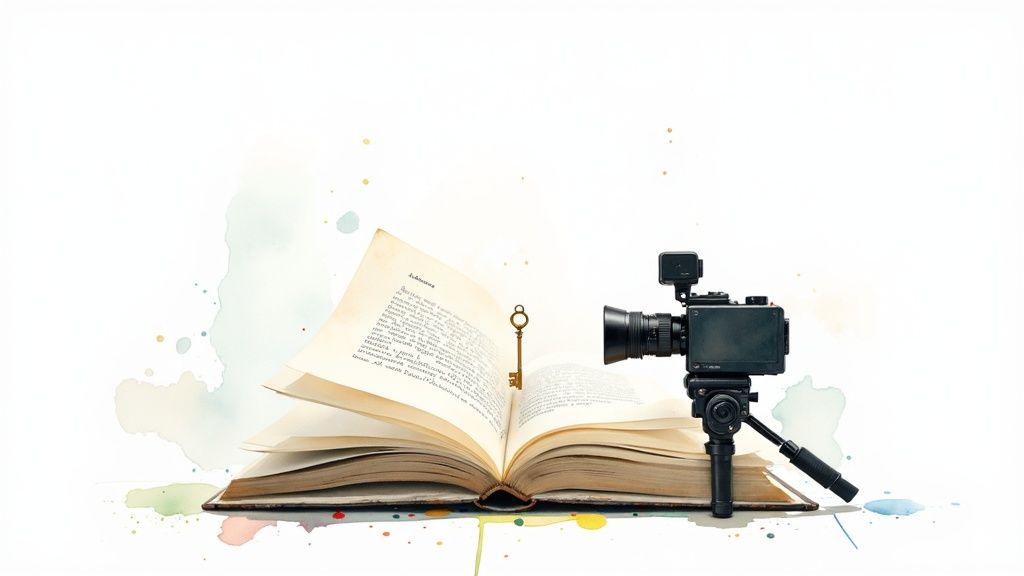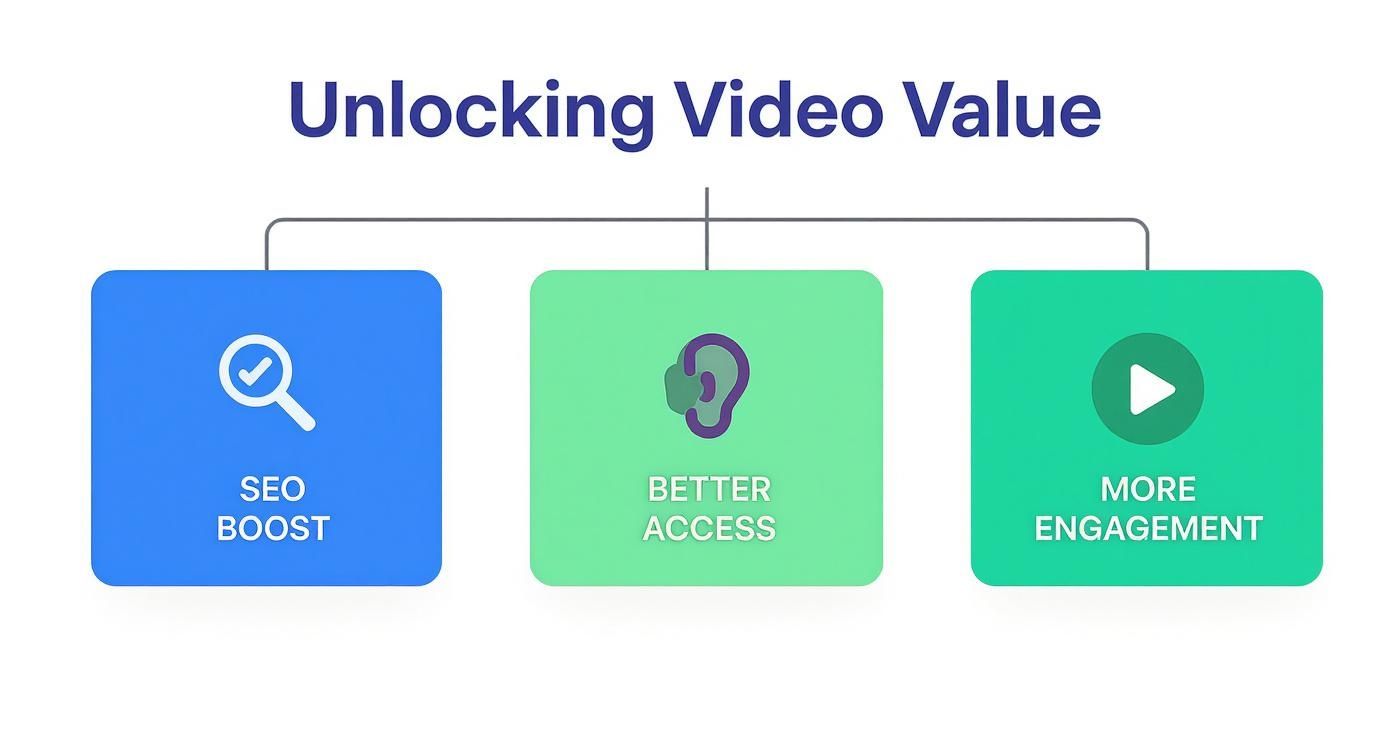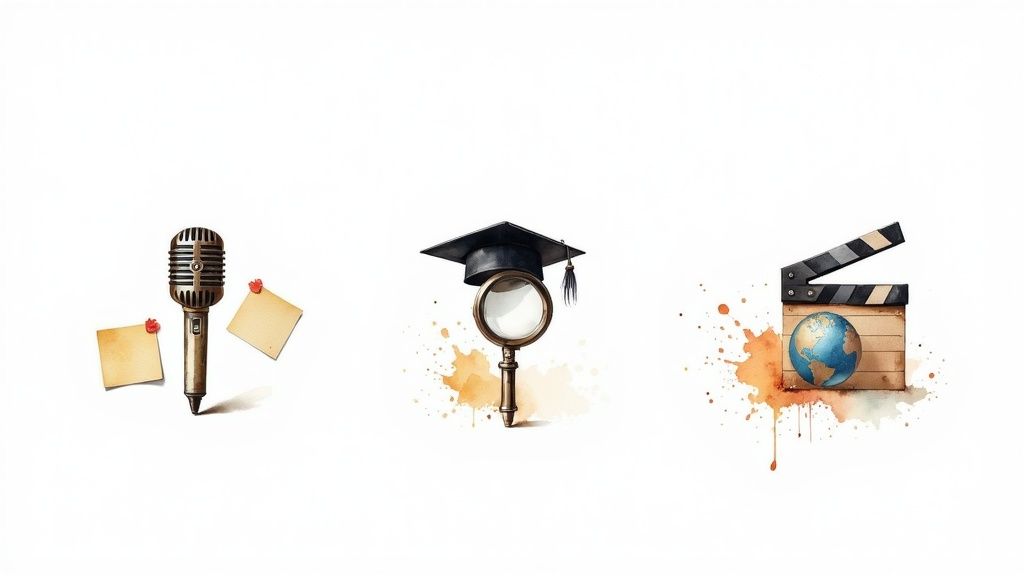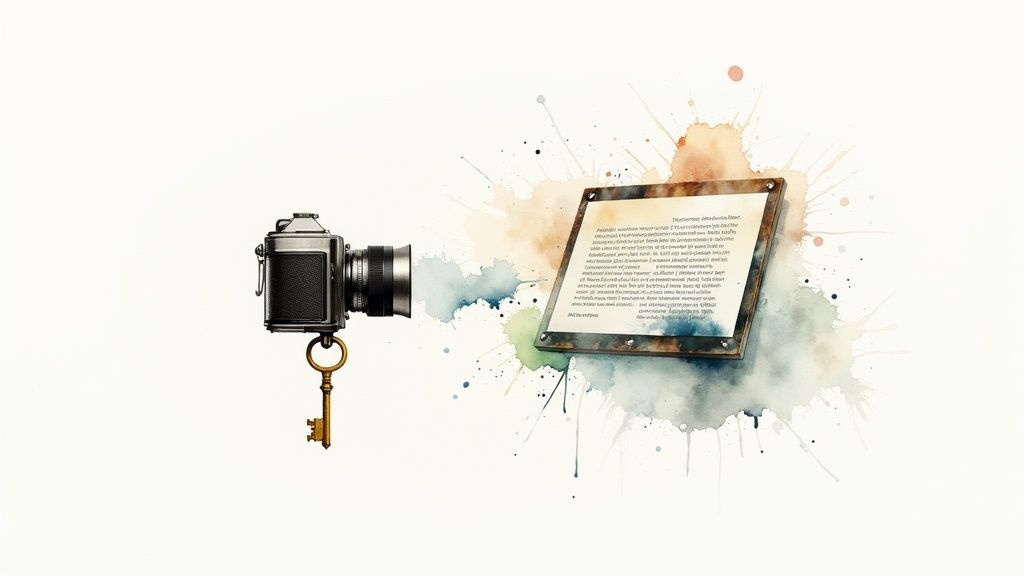What is video transcription? Learn how converting video to text boosts your SEO, improves accessibility, and unlocks new content opportunities for your brand.
In This Article
Subscribe to our newsletter
So, what exactly is video transcription?
At its simplest, it’s the process of turning all the spoken words in a video into a written text document. Think of it this way: your video is like a locked book. It’s full of great ideas, but search engines can’t read it, and many people can't access it. Transcription is the key that unlocks that book, transforming dialogue into powerful, searchable content.
Breaking Down Video Transcription

Digging a little deeper, understanding video transcription is about recognizing its power to completely transform your content. It isn't just about creating a text file on the side; it's a core strategy for anyone serious about getting the most out of their video’s reach and impact.
The process captures every bit of dialogue and narration—sometimes even key non-verbal sounds—to create a complete record of your video’s audio.
This one simple act makes your content incredibly versatile. Suddenly, a piece of media that was a total black box to Google becomes fully indexable, allowing search engines to finally understand and rank it. It's no wonder the global market for these services is blowing up.
The online audio and video transcription services market was valued at around USD 2.6 billion and is expected to grow with a Compound Annual Growth Rate (CAGR) of roughly 15% over the next decade. That growth is a clear sign of the surging demand from industries like media, education, and legal services.
Why It’s More Than Just Words
Beyond the technical definition, transcription is a multi-tool for content creators. It offers a whole suite of benefits that go far beyond just having a text document.
Here’s what you really get:
- Improved Accessibility: It opens up your videos to people with hearing impairments and also caters to viewers who’d just rather read than watch or listen.
- Enhanced SEO Performance: Transcripts are packed with keyword-rich text that search engines can crawl, which can dramatically boost your video's discoverability.
- Greater User Engagement: It lets viewers quickly scan for the parts they care about or follow along in a noisy place without needing headphones.
- Effortless Content Repurposing: A transcript is the perfect raw material for spinning off blog posts, social media updates, articles, and more.
For a solid primer on transcription and all its uses, check out A Guide to Transcribing Audio Files. It does a great job of breaking down how the process makes audio content more accessible and useful across the board.
So, you have a great video. What now?
Thinking of transcription as just a text file of your video is missing the bigger picture. It’s actually about turning that single video into a versatile asset that pulls its weight and drives real results for your business. It's not about documentation; it's a strategic move.
This all comes down to three key wins: making sure search engines can find you, opening up your content to everyone, and keeping your audience hooked. Each of these transforms your video from a simple recording into a marketing powerhouse.
Boost Your Search Engine Optimization
Let's be blunt: Google and other search engines are amazing at reading text, but they can't "watch" your video to figure out what it's about. A transcript is basically a cheat sheet you hand them, letting them read, index, and rank every single word you say.
Suddenly, every spoken phrase becomes a keyword that can pull in organic traffic. You’re giving search engines a rich, detailed script of your video's topic, which helps you show up in relevant searches. This gets your content in front of a far wider audience than a platform like YouTube ever could on its own. For instance, experts on efficient video interview recording often point out how transcription is a game-changer for content analysis, and that same benefit applies directly to searchability.
Radically Improve Accessibility
True accessibility means everyone gets to engage with your content, no holds barred. Video transcription is one of the cornerstones of making that happen. For viewers with hearing impairments, a transcript isn't a "nice-to-have"—it's the only way they can access your message.
But the ripple effects go further. Transcripts are also a lifeline for people with cognitive or attention-related challenges who find reading easier than listening. It’s a simple, powerful way to align with the Web Content Accessibility Guidelines (WCAG) and signal that your brand is serious about inclusivity.
It's not just about meeting specific needs, either. A surprising number of people simply prefer to read. They use transcripts to quickly scan for the good parts or to consume content in a quiet office without headphones.
Drive Deeper User Engagement
Transcription also plays right into how people watch videos today. Think about it—how often do you scroll through your phone in a public place with the sound off? A transcript lets people follow along without audio, keeping them locked in when they’d otherwise just keep scrolling.
Plus, a transcript doubles as a handy reference guide. Viewers can quickly search for and jump back to key moments without having to scrub through the whole video. One study on viewing habits found that nearly a quarter of people read transcripts while watching a video just to make sure they don’t miss a single important detail. That means better retention and a much more engaged audience.
Human vs. AI Transcription: Which Method is Right for You?
So you've decided to transcribe your videos. Great move. Now you’re at a crossroads: do you hire a human professional or use an AI-powered service? This isn't just a small technical detail; it's a strategic decision that will directly impact the quality, speed, and cost of your project. Each path has its own clear advantages, and the right choice really boils down to your specific needs.
The Case for Human Transcription
Think of human transcription as a bespoke, white-glove service. It’s the only way to go when you need absolute precision and can't afford any mistakes.
For really sensitive or nuanced content—things like legal depositions, detailed medical records, or in-depth interviews loaded with jargon—a human expert is simply irreplaceable. They can pick up on sarcasm, tell speakers apart even with background noise, and easily navigate thick accents. A human transcriber ensures the final text doesn’t just capture the words, but the intent behind them.
The Rise of AI Transcription
On the flip side, AI transcription is the powerhouse built for speed and volume. Using complex algorithms, these tools can process audio and spit out a text file in a fraction of the time it would take a person.
This makes AI the perfect solution when you're dealing with a large amount of content and time is of the essence. Think social media clips, internal company meetings, or archives of university lectures. The growth here has been explosive—the global AI transcription market is expected to jump from USD 4.5 billion to USD 19.2 billion over the next decade. That’s a huge indicator of how much businesses are relying on this tech. With top-tier tools now hitting up to 99% accuracy in good conditions, AI offers a seriously efficient option for most everyday needs. You can discover more about the AI transcription market's impressive growth to see how it's shaking up industries.
This decision tree shows how transcription unlocks value by boosting SEO, improving access, and driving engagement.

No matter which route you take, the core benefits are the same. You're making your content more accessible, more searchable, and ultimately, more valuable.
Making the Right Choice for Your Content
So, how do you actually choose? It comes down to a simple balancing act between three key factors: accuracy, speed, and cost. To help you weigh your options, here’s a quick breakdown.
Comparing Human and AI Video Transcription Methods
This table offers a direct comparison of manual and AI-powered transcription, helping you decide which is the right fit for your project.
| Attribute | Human Transcription | AI Transcription |
|---|---|---|
| Accuracy | Extremely high (99%+), excels with nuance, accents, and poor audio. | Very high (up to 99%), but struggles with heavy accents, jargon, and background noise. |
| Speed | Slower; a one-hour video can take several hours to transcribe. | Extremely fast; a one-hour video can be done in minutes. |
| Cost | Higher, typically priced per minute of audio/video. | Much lower, often a low monthly subscription or small per-minute fee. |
| Nuance & Context | Excellent. Can interpret sarcasm, emotion, and identify multiple speakers easily. | Limited. Struggles to understand context, tone, or distinguish between similar voices. |
| Best For | Legal, medical, scripted media, and qualitative research interviews. | Meetings, lectures, social media clips, and first-draft transcriptions. |
At the end of the day, there's a place for both. Your decision should be guided by the stakes of your project and its final destination.
Choosing between human and AI isn't about which is "better" overall, but which is better for a specific job. For a quick, low-stakes draft, AI is a clear winner. For a polished, public-facing transcript, a human touch is often essential.
Platforms like Aeon bridge this gap by integrating advanced AI to automate video creation from text, making the transcription process seamless. By turning your spoken words into accurate text, Aeon provides the foundation for creating multiple video assets efficiently.
Ultimately, your choice should always align with your content’s purpose.
- High-stakes legal or medical content? Go with a human. No question.
- Need to process 100 customer feedback videos by tomorrow? AI is your best friend.
- Creating a polished marketing video? A hybrid approach often works best. Use AI to get a fast first draft, then have a human review and perfect it. You get the best of both worlds: speed and quality.
Real-World Examples of Video Transcription in Action

It’s one thing to understand the what of video transcription, but seeing it work in the real world is where it really clicks. Across countless industries, this simple process unlocks massive value, turning spoken dialogue into a tangible, strategic asset. We're talking about a genuine return on investment, not just a handy text file.
Think about a marketing team, for instance. They host a single one-hour webinar. With a transcript, they can instantly pull killer quotes for social media, spin off ten different blog posts on specific topics, and build out an entire FAQ document. Just like that, they’ve multiplied the value of their original effort.
Applications Across Different Sectors
The power of transcription isn’t limited to one or two fields; it extends into just about every professional corner you can imagine, each with its own unique goals. The demand is so widespread it’s created a booming market.
In fact, the U.S. transcription market was valued at USD 30.42 billion and is projected to keep growing, thanks to heavy demand in sectors like legal, media, and education. You can dive deeper into the U.S. transcription market data to see exactly how these industries are fueling its expansion.
Here’s a snapshot of how different pros are putting transcripts to work:
- Educational Institutions: A university can transcribe its entire lecture library. This gives students the power to instantly search for a specific term or concept a professor mentioned weeks ago, making study and research way more efficient.
- Media and Entertainment: Production houses use transcripts to rapidly generate subtitles and closed captions, opening their content to global audiences. It's not just about accessibility—it also boosts performance on social platforms where most videos are watched on mute.
- Legal Firms: In the legal world, accuracy is everything. Firms depend on precise, verbatim transcripts of depositions, hearings, and court proceedings. These aren't just notes; they're official records for building and reviewing cases.
Driving Business and Legal Precision
Beyond content and education, transcription is a critical tool for clarity and record-keeping in corporate and legal environments. A clean text version of a video meeting can instantly settle any disputes over what was said or agreed upon.
For a legal team, a transcript isn't just a convenience—it's a foundational piece of evidence. It transforms fleeting spoken words into a permanent, verifiable document that can be crucial in building a case or ensuring compliance.
This process is also a game-changer for qualitative research, where analysts sift through hours of interview footage to spot patterns and insights. A searchable transcript makes this daunting task manageable, saving hundreds of hours of painstaking manual work.
Each of these examples shows how transcription converts a video from a one-time broadcast into a lasting, multipurpose resource.
Best Practices for Getting Accurate Transcripts
Getting a high-quality transcript starts long before you ever hit the "transcribe" button. The final accuracy of your text—whether generated by a human or AI—is directly tied to the quality of your original recording. Think of it like building a house: a strong foundation makes everything else much more stable.
The single most important factor is audio clarity. A clean, crisp recording is the best friend of any transcription process. This doesn't mean you need a professional studio, but nailing a few basics can make a world of difference.
Prepare for a Clean Recording
First, get your environment under control. Find a quiet room with minimal background noise, echoes, or interruptions. Even small sounds like a humming air conditioner or distant traffic can easily confuse transcription software or stump a human transcriber.
Next, think about your equipment.
- Use a Decent Microphone: A dedicated external mic will almost always deliver better results than the one built into your laptop or phone. It’s designed to capture richer sound and filter out ambient noise.
- Position the Mic Correctly: Keep the microphone a consistent distance from each speaker. This simple step ensures the volume levels stay even and prevents words from getting lost or sounding muffled.
- Speak Clearly: Encourage everyone on the recording to enunciate their words and speak at a steady, natural pace. Rushing or mumbling is a surefire way to introduce errors.
Provide Context for Better Accuracy
Another pro tip is to give your transcriber—whether human or AI—a heads-up on any unique terminology. If your video mentions specific names, industry acronyms, or company jargon, pull together a quick glossary.
This small step acts as a cheat sheet, dramatically improving accuracy by giving the transcription process context for unfamiliar words. It's especially vital for technical, medical, or legal content.
Finally, always plan for a human review. Even the most advanced AI can misinterpret a thick accent or a complex phrase. A quick proofread lets you catch any small errors, ensuring your transcript is polished, professional, and perfectly represents your content. This final check is what turns a good transcript into a great one.
Got questions about video transcription? You're not alone. When people first start exploring how to turn their spoken content into text, a few common queries always pop up. Let's clear the air on some of the big ones.
How Accurate Is AI Video Transcription, Really?
This is the million-dollar question, and the honest answer is: it depends on your audio quality. If you’ve got a crystal-clear recording with minimal background noise, top-tier AI services can nail it with up to 99% accuracy.
But the real world is messy. Things like thick accents, multiple people talking over each other, or that coffee shop buzz in the background can trip up the AI and drag the accuracy down. For most everyday business uses, AI gives you a fantastic starting draft. Just remember, for anything mission-critical, a quick human proofread is always a smart final step.
People often use "transcripts" and "captions" interchangeably, but they're two different tools with distinct jobs. Understanding the difference is key to a solid content strategy.
What’s the Difference Between Transcripts and Captions?
Think of a transcript as the full script of your video—a single text document containing every word that was said. It's an SEO goldmine and makes it a breeze to repurpose your video into articles, social posts, or show notes.
Captions, on the other hand, are the timed text chunks you see right on the video screen. They are absolutely essential for accessibility and for hooking viewers scrolling with the sound off (which is most people on social media). The good news? Once you have a transcript, adding timestamps to create captions is a straightforward process.
How Much Does Video Transcription Cost?
The price tag can swing wildly depending on the path you choose. AI-powered transcription services are incredibly budget-friendly, often charging just pennies per minute or a flat monthly subscription. It's fast and efficient.
Hiring a human to do it—manual transcription—is the premium option. It costs more because it’s a detailed, time-consuming job. But for audio that's complex, has poor quality, or requires absolute perfection, that human touch guarantees the highest possible accuracy.
Ready to turn your ideas into compelling videos without the hassle? Aeon makes it happen. Start creating with Aeon today.


.jpg)